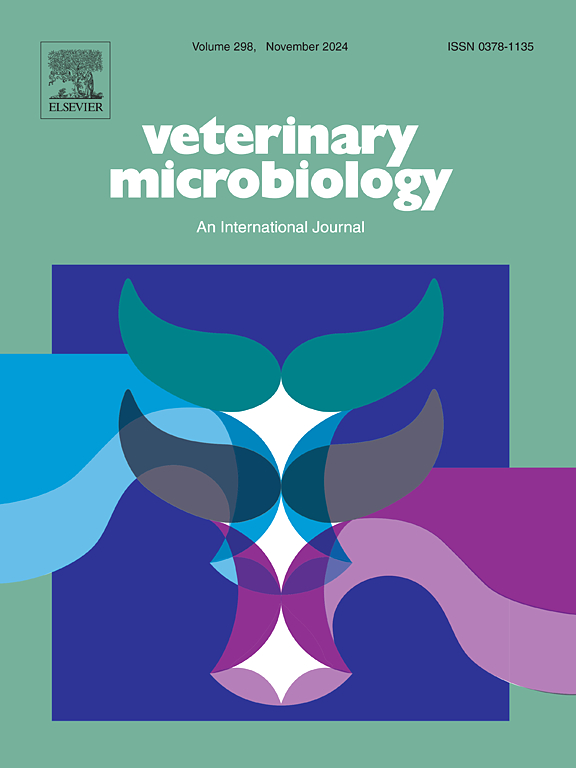Pseudorabies virus DNA binding to porcine NLRC3 unleashes the activation of the porcine NLRP3 inflammasome
IF 2.4
2区 农林科学
Q3 MICROBIOLOGY
引用次数: 0
Abstract
Viral infection activates multiple inflammatory pathways, with the NLRP3 inflammasome playing a pivotal role in host defense. However, negative regulation of the NLRP3 inflammasome is essential for maintaining host homeostasis. Here, we report that double-stranded DNA (dsDNA) from pseudorabies virus (PRV) induces NLRP3 inflammasome activation and pyroptosis through gasdermin D (GSDMD) cleavage and IL-1β secretion. Importantly, the inhibitory NLR porcine NLRC3 (pNLRC3) interacts with porcine NLRP3 (pNLRP3) and attenuates GSDMD cleavage and IL-1β release. Upon PRV infection, overexpression of pNLRC3 enhances GSDMD cleavage and lactate dehydrogenase release, whereas knockdown of pNLRC3 reduces pyroptosis. Mechanistically, pNLRC3 binds PRV dsDNA and unleashes its inhibitory effect on pNLRP3, functioning as a checkpoint to regulate inflammasome activation. Furthermore, pNLRC3 contributes to PRV restriction by controlling viral replication and limiting infection. In summary, our findings reveal a dual role of pNLRC3, acting both as a negative regulator of the pNLRP3 inflammasome and as a viral sensor that regulates pyroptosis-mediated viral clearance. These insights provide a deeper understanding of virus-host interactions and innate immune regulation.
伪狂犬病毒DNA结合猪NLRC3释放猪NLRP3炎性体的激活
病毒感染激活多种炎症途径,其中NLRP3炎症小体在宿主防御中起关键作用。然而,NLRP3炎性小体的负向调控对于维持宿主体内平衡至关重要。本文报道了伪狂犬病毒(PRV)的双链DNA (dsDNA)通过裂解气皮蛋白D (GSDMD)和分泌IL-1β诱导NLRP3炎性体激活和焦亡。重要的是,抑制NLR的猪NLRC3 (pNLRC3)与猪NLRP3 (pNLRP3)相互作用,减少GSDMD的裂解和IL-1β的释放。PRV感染后,pNLRC3过表达可促进GSDMD裂解和乳酸脱氢酶释放,而pNLRC3过表达可减少焦亡。机制上,pNLRC3结合PRV dsDNA并释放其对pNLRP3的抑制作用,作为调节炎性体激活的检查点。此外,pNLRC3通过控制病毒复制和限制感染来限制PRV。总之,我们的研究结果揭示了pNLRC3的双重作用,既作为pNLRP3炎症小体的负调节因子,又作为调节焦热介导的病毒清除的病毒传感器。这些见解提供了对病毒-宿主相互作用和先天免疫调节的更深层次的理解。
本文章由计算机程序翻译,如有差异,请以英文原文为准。
求助全文
约1分钟内获得全文
求助全文
来源期刊

Veterinary microbiology
农林科学-兽医学
CiteScore
5.90
自引率
6.10%
发文量
221
审稿时长
52 days
期刊介绍:
Veterinary Microbiology is concerned with microbial (bacterial, fungal, viral) diseases of domesticated vertebrate animals (livestock, companion animals, fur-bearing animals, game, poultry, fish) that supply food, other useful products or companionship. In addition, Microbial diseases of wild animals living in captivity, or as members of the feral fauna will also be considered if the infections are of interest because of their interrelation with humans (zoonoses) and/or domestic animals. Studies of antimicrobial resistance are also included, provided that the results represent a substantial advance in knowledge. Authors are strongly encouraged to read - prior to submission - the Editorials (''Scope or cope'' and ''Scope or cope II'') published previously in the journal. The Editors reserve the right to suggest submission to another journal for those papers which they feel would be more appropriate for consideration by that journal.
Original research papers of high quality and novelty on aspects of control, host response, molecular biology, pathogenesis, prevention, and treatment of microbial diseases of animals are published. Papers dealing primarily with immunology, epidemiology, molecular biology and antiviral or microbial agents will only be considered if they demonstrate a clear impact on a disease. Papers focusing solely on diagnostic techniques (such as another PCR protocol or ELISA) will not be published - focus should be on a microorganism and not on a particular technique. Papers only reporting microbial sequences, transcriptomics data, or proteomics data will not be considered unless the results represent a substantial advance in knowledge.
Drug trial papers will be considered if they have general application or significance. Papers on the identification of microorganisms will also be considered, but detailed taxonomic studies do not fall within the scope of the journal. Case reports will not be published, unless they have general application or contain novel aspects. Papers of geographically limited interest, which repeat what had been established elsewhere will not be considered. The readership of the journal is global.
 求助内容:
求助内容: 应助结果提醒方式:
应助结果提醒方式:


